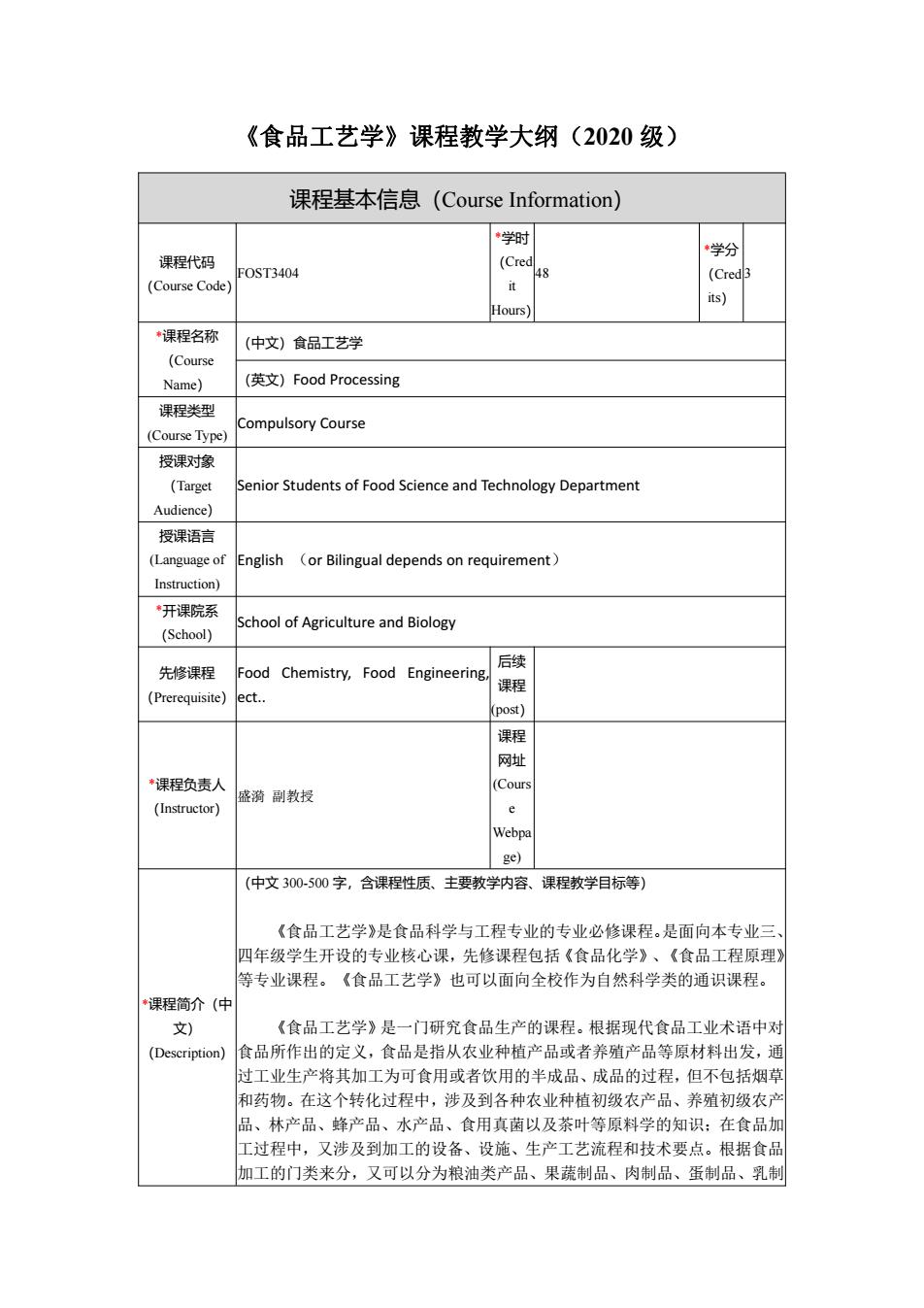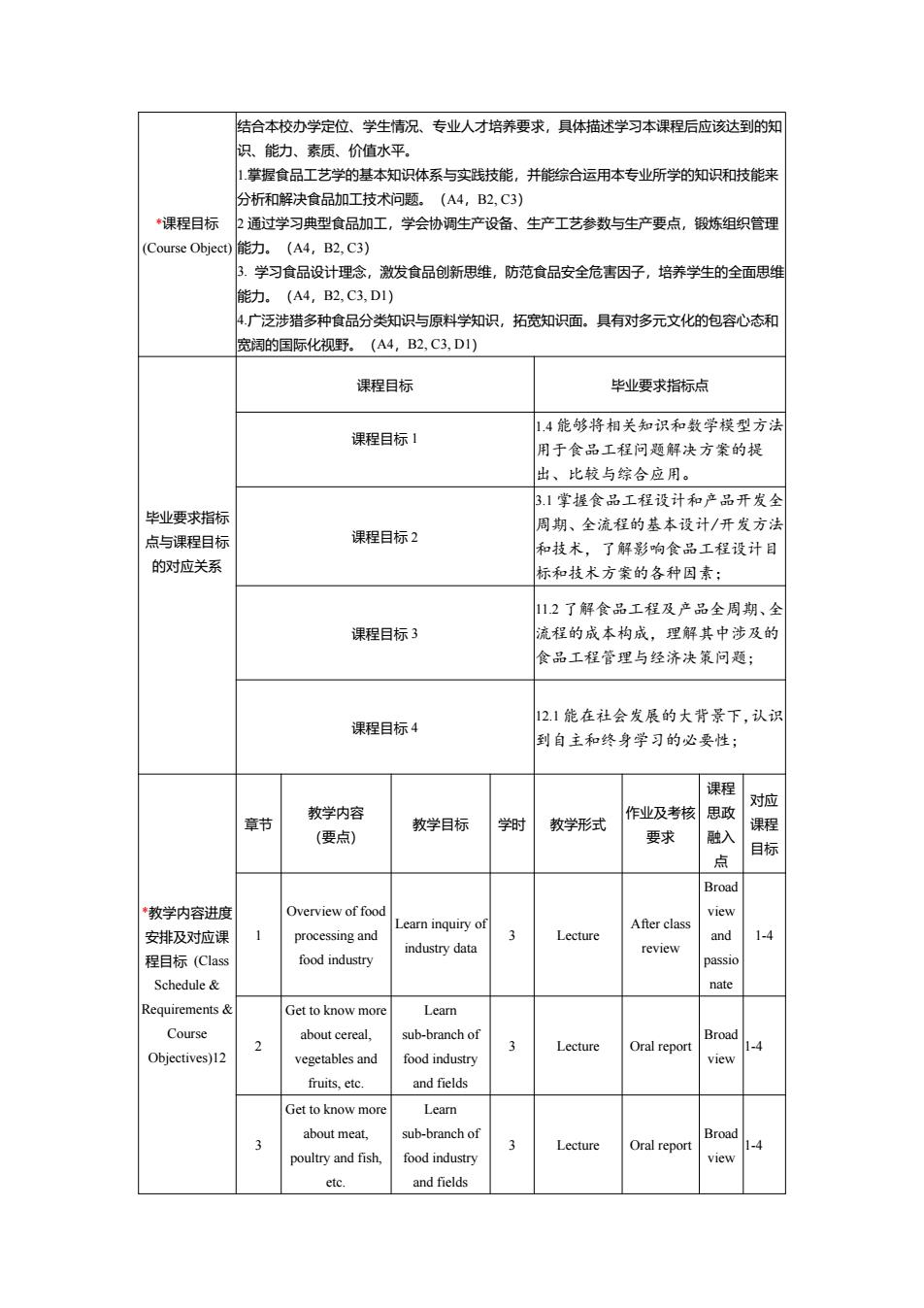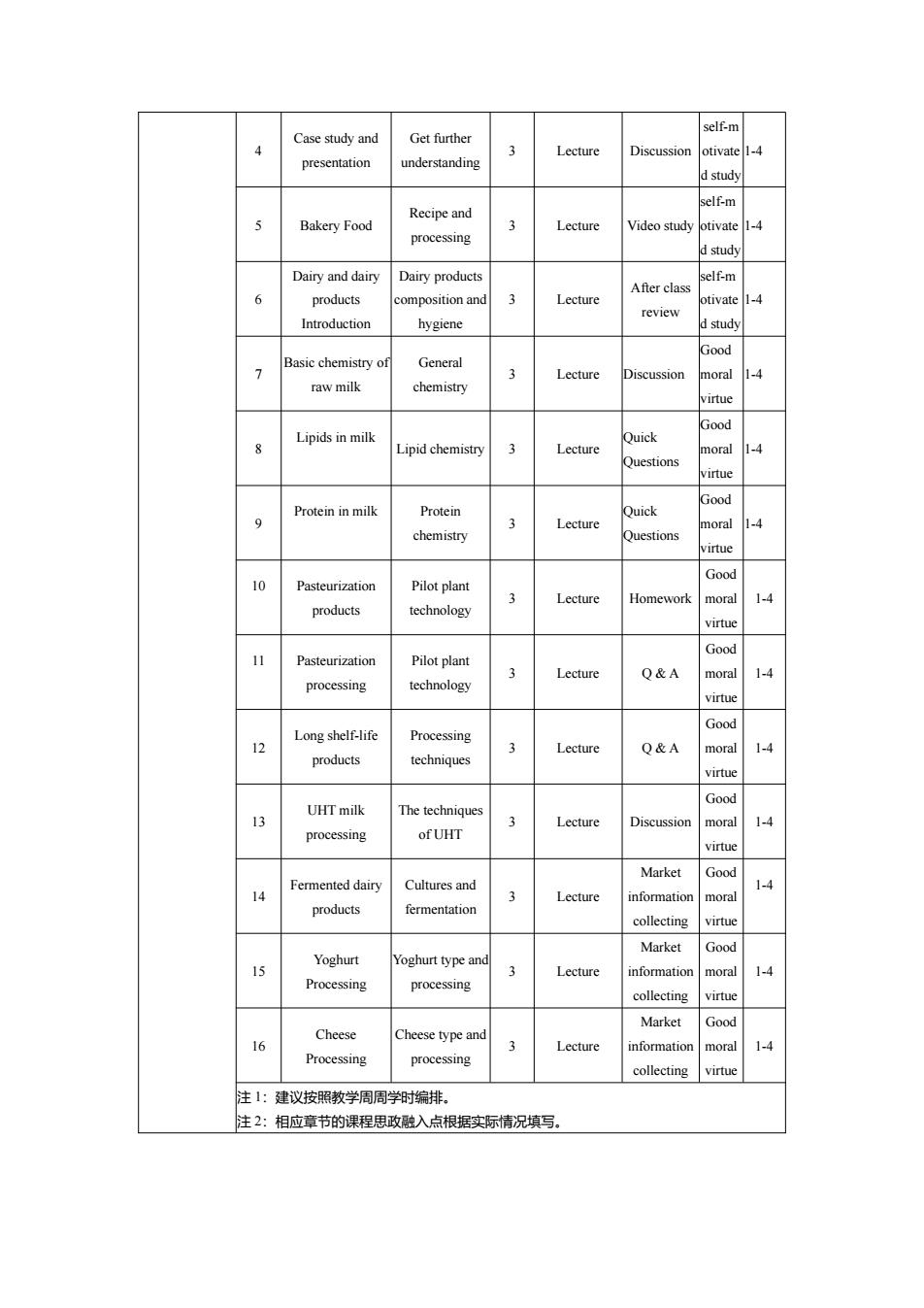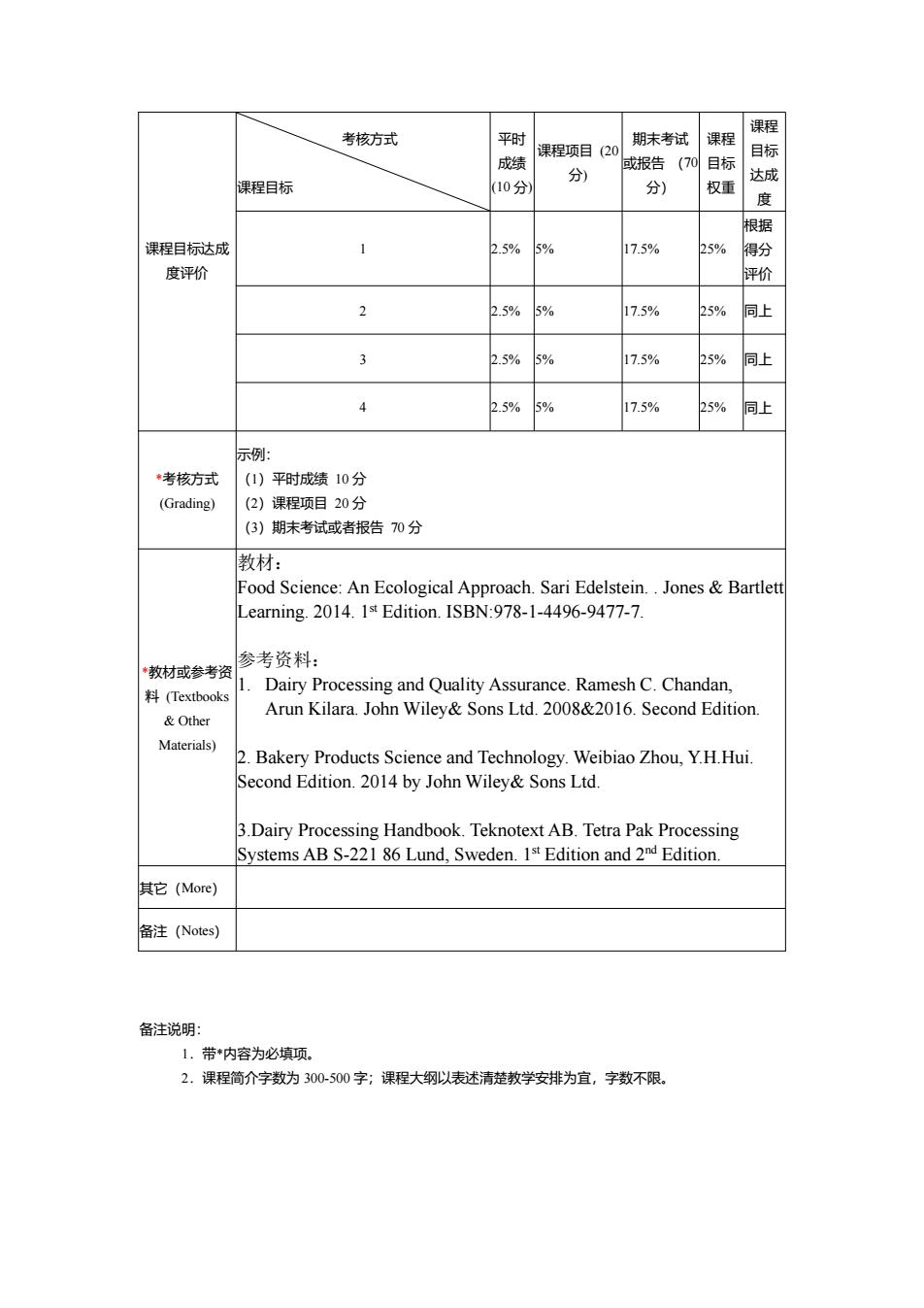
《食品工艺学》课程教学大纲(2020级) 课程基本信息(Course Information) 学时 课程代码 F0ST3404 (Cre (Course Cod Hours) 课程名称 (中文)食品工艺学 (英文)Food Processing 课程类型 Compulsory Course (Course Type) 授课对橡 (Targe enior Students of Food Science and Technology Department Audience】 授课语言 (Languageo English (or Bilingual depends on requirement) 开课院系 School of Agriculture and Biology (School) 先修课程 Food Chemistry,Food Engineering, 后续 (Prerequisite)ect. 课程 post) 课程 “课程负责人 盛副教投 (Co (Instructor)】 Webpa ge) (中文300500字,含课程性质、主要教学内容、课程教学目标等) 《食品工艺学》是食品科学与工程专业的专业必修课程。是面向本专业 四年级学生开设的专业核心课,先修课程包括《食品化学》、《食品工程原理》 等专业课程。《食品工艺学》也可以面向全校作为自然科学类的通识课程 课程简介(中 ) 《食品工艺学》是一门研究食品生产的课程。根据现代食品工业术语中 (Deseription)食品所作出的定义,食品是指从农业种植产品或者养殖产品等原材料出发,通 过工业生产将其加工为可食用或者饮用的半成品、成品的过程,但不包括烟等 和药物。在这个转化过程中,涉及到各种农业种植初级农产品、养殖初级农产 品、林产品、蜂产品、水产品、食用真菌以及茶叶等原料学的知识:在食品加 工过程中,又涉及到加工的设备、设施、生产工艺流程和技术要点。根据食品 加工的门类来分,又可以分为粮油类产品、果蔬制品、肉制品、蛋制品、乳制
《食品工艺学》课程教学大纲(2020 级) 课程基本信息(Course Information) 课程代码 (Course Code) FOST3404 *学时 (Cred it Hours) 48 *学分 (Cred its) 3 *课程名称 (Course Name) (中文)食品工艺学 (英文)Food Processing 课程类型 (Course Type) Compulsory Course 授课对象 (Target Audience) Senior Students of Food Science and Technology Department 授课语言 (Language of Instruction) English (or Bilingual depends on requirement) *开课院系 (School) School of Agriculture and Biology 先修课程 (Prerequisite) Food Chemistry, Food Engineering, ect.. 后续 课程 (post) *课程负责人 (Instructor) 盛漪 副教授 课程 网址 (Cours e Webpa ge) *课程简介(中 文) (Description) (中文 300-500 字,含课程性质、主要教学内容、课程教学目标等) 《食品工艺学》是食品科学与工程专业的专业必修课程。是面向本专业三、 四年级学生开设的专业核心课,先修课程包括《食品化学》、《食品工程原理》 等专业课程。《食品工艺学》也可以面向全校作为自然科学类的通识课程。 《食品工艺学》是一门研究食品生产的课程。根据现代食品工业术语中对 食品所作出的定义,食品是指从农业种植产品或者养殖产品等原材料出发,通 过工业生产将其加工为可食用或者饮用的半成品、成品的过程,但不包括烟草 和药物。在这个转化过程中,涉及到各种农业种植初级农产品、养殖初级农产 品、林产品、蜂产品、水产品、食用真菌以及茶叶等原料学的知识;在食品加 工过程中,又涉及到加工的设备、设施、生产工艺流程和技术要点。根据食品 加工的门类来分,又可以分为粮油类产品、果蔬制品、肉制品、蛋制品、乳制

品、水产食品、软饮料产品、世培类产品、镀果与巧吉力制品、休闲影化举食 品、调味品等类别。结合现实条件与地区经济的特点,我们将选取重点、有典 型代表意文义的一些食品加工门类作为课程教学的主体内容。 通过课堂教学,使学生了解食品加工的门类、重点类别食品加工工艺过程 掌握在食品加工过程中所普遍采用的原材料、添加剂、所涉及的工艺流程、设 施设备和技术要点。进而了解并掌握从农业初级产品通过工业化的加工过程, 转化为可食用或者饮用的物质的过程。并能深入理解现代食品加工与食品质量 及安全之间的关系,为应用专业知识和技能解决生产实际需要奠定基 (英文300-500字判) The subject of food science includes the study of plant and animal sources at the celluar level.Different species have evolved based on genetic changes over time.Food scientists are being challenged to provide food that is rich in nutrients(food composition and quality),cost-effective,and available to all people(food technology and delivery system). Food for the senior students of Food Scien and Technology Department.It is also a core major course in the whole curriculur program.The prerequisite courses could be 'Food chemistry,Food Engineering' Food Microbiology'and Food Safety',but not required absolutely. F courseon how toproduce different kind of food product cording to the terminology of modern food industry,it studies on the transformation of raw materials and ingredients,by physical or chemical means 课程简介(英 into industrial edible or potable products,not including tobacco and medicine. 文) Description】 Food processing typically takesclean,harvested or culled crops or butchered animal prod ucts an processes these produce attractive,marketable e and often ong shelf-life manufactured food products.There are a variety of food product and their foods processing.Based on local economy,we focused on dairy products,bakery products and beverages and their processing in this curriculum. For example,a dairy product is food produced from the milk of mammals.Raw milk collection,milk components and chemistry,liquid milk products,milk powde condensed milk,fermented milk products,yogurts and cheese are taught in this section. students after Food Processing.shoud totaly understand basic nowledge of food industry,food products and itstransformation. 课程目标与内容(Course objectives and contents)
品、水产食品、软饮料产品、烘焙类产品、糖果与巧克力制品、休闲膨化类食 品、调味品等类别。结合现实条件与地区经济的特点,我们将选取重点、有典 型代表意义的一些食品加工门类作为课程教学的主体内容。 通过课堂教学,使学生了解食品加工的门类、重点类别食品加工工艺过程。 掌握在食品加工过程中所普遍采用的原材料、添加剂、所涉及的工艺流程、设 施设备和技术要点。进而了解并掌握从农业初级产品通过工业化的加工过程, 转化为可食用或者饮用的物质的过程。并能深入理解现代食品加工与食品质量 及安全之间的关系,为应用专业知识和技能解决生产实际需要奠定基础。 *课程简介(英 文) (Description) (英文 300-500 字) The subject of food science includes the study of plant and animal sources at the cellular level. Different species have evolved based on their environments and genetic changes over time. Food scientists are being challenged to provide food that is rich in nutrients (food composition and quality), cost‐effective, and available to all people (food technology and delivery system). 《Food Processing》is a compulsory course for the senior students of Food Science and Technology Department. It is also a core major course in the whole curriculum program. The prerequisite courses could be ‘Food chemistry’, ‘Food Engineering’ , ‘Food Microbiology’ and ‘Food Safety’, but not required absolutely. 《Food Processing》is a course on how to produce different kind of food products. According to the terminology of modern food industry, it studies on the transformation of raw materials and ingredients, by physical or chemical means into industrial edible or potable products, not including tobacco and medicine. Food processing typically takes clean, harvested or culled crops or butchered animal products and processes these produce attractive, marketable and often long shelf‐life manufactured food products. There are a variety of food products and their foods processing. Based on local economy, we focused on dairy products, bakery products and beverages and their processing in this curriculum. For example, a dairy product is food produced from the milk of mammals. Raw milk collection, milk components and chemistry, liquid milk products, milk powder, condensed milk, fermented milk products, yogurts and cheese are taught in this section. Students after learning Food Processing, should totally understand basic knowledge of food industry, food products and its transformation. 课程目标与内容(Course objectives and contents)

结合本校功学定位、学生情况.专业人才培苏要求,具体描沫学习本课程后应该达到的知 学的基本知 体系与实践技能,并能综合运用本专业所学的知识和技能 分析和解决食品加工技术问题。(A4,B2,C3) 课程目标上通过学习典型食品加工,学会协调生产设备、生产工艺参数与生产要点,锻炼组织管理 (Course Obiect)能力,(A4.B2.C3) 3.学习食品设计理念,激发食品创新思维,防范食品安全危害因子,培养学生的全面思维 (A4,B2,C3,DI) 4广泛涉猎多种食品分类知识与原料学知识,拓宽知识面。具有对多元文化的包容心态和 宽阔的国际化视野。(A4,B2,C3,D1) 课程目标 毕判业要求指标点 .4能够将相关知识和数学模型方法 课程日标1 用千食总工程问题程法方的提 出 比较与综合应用。 31掌提食品工程设计和产品开发全 华业要求指 周期、全流程的基本设计/开发方法 点与课程目椅 课程目标2 和技求了解影响食品工程设计目 的对应关系 标和技术方策的各种因素: 12了解食品工程及产品全周期、全 课程目标3 流程的成本构成,理解其中涉及的 食品工程管理与经济决策问题: 121能在社会发展的大背景下,认 课程目标4 自主和终身学习的必要性: 课程 教学内容 作业及考核思政 草节 教学目标 教学形式 (要点) 要求 入 课程 点 目标 Broad 款学内容讲商 Overview of foo earn inquiry of After clas 安及对应课 processing and 3 Lecture and 程目标(C industry at Schedule nate Requirements Get to know more Leamn Course about cereal sub-branch of Broad 2 Lecture Oral repor Obiectives)12 vegetables and food industry fruits,et and fields Get to know more Leam about meat. sub-branch of Broad Lecture Oral repor oultry and fish. food industry and fields
*课程目标 (Course Object) 结合本校办学定位、学生情况、专业人才培养要求,具体描述学习本课程后应该达到的知 识、能力、素质、价值水平。 1.掌握食品工艺学的基本知识体系与实践技能,并能综合运用本专业所学的知识和技能来 分析和解决食品加工技术问题。(A4,B2, C3) 2 通过学习典型食品加工,学会协调生产设备、生产工艺参数与生产要点,锻炼组织管理 能力。(A4,B2, C3) 3. 学习食品设计理念,激发食品创新思维,防范食品安全危害因子,培养学生的全面思维 能力。(A4,B2, C3, D1) 4.广泛涉猎多种食品分类知识与原料学知识,拓宽知识面。具有对多元文化的包容心态和 宽阔的国际化视野。(A4,B2, C3, D1) 毕业要求指标 点与课程目标 的对应关系 课程目标 毕业要求指标点 课程目标 1 1.4 能够将相关知识和数学模型方法 用于食品工程问题解决方案的提 出、比较与综合应用。 课程目标 2 3.1 掌握食品工程设计和产品开发全 周期、全流程的基本设计/开发方法 和技术,了解影响食品工程设计目 标和技术方案的各种因素; 课程目标 3 11.2 了解食品工程及产品全周期、全 流程的成本构成,理解其中涉及的 食品工程管理与经济决策问题; 课程目标 4 12.1 能在社会发展的大背景下,认识 到自主和终身学习的必要性; *教学内容进度 安排及对应课 程目标 (Class Schedule & Requirements & Course Objectives)12 章节 教学内容 (要点) 教学目标 学时 教学形式 作业及考核 要求 课程 思政 融入 点 对应 课程 目标 1 Overview of food processing and food industry Learn inquiry of industry data 3 Lecture After class review Broad view and passio nate 1-4 2 Get to know more about cereal, vegetables and fruits, etc. Learn sub-branch of food industry and fields 3 Lecture Oral report Broad view 1-4 3 Get to know more about meat, poultry and fish, etc. Learn sub-branch of food industry and fields 3 Lecture Oral report Broad view 1-4

Get further self-m presentation understanding self-m Recipe and Bakery Food processing Dairy and dairy Dairy products After clas self-m 6 products omposition and Lecture w review Introduction hygiene General Good mora raw milk chemistry virtue Good Lipidsinmilk Lipid chemistr tions Good Protein in milk Protein ck 9 Lecture moral chemistry virtue G00 10 Pasteurizatio Pilot plan Lecture mora products technology virtue Pasteurizatio Pilot plan ecture Q&A processing technology virtue Good Long shelf-life Processing 2 products 3 &A UHT milk The techniques 13 Lecture moral processing ofUHT virtue Fermented dair Cultures and 3 Lecture a山 products fermentation collecting virtue Market Yoghur Good ecture Processing processing virtue Market G00 1- processing collecting 注1:建议按照教学周周学时编排, 注2:相应章节的课程思政融入点根据实际情况填写
4 Case study and presentation Get further understanding 3 Lecture Discussion self-m otivate d study 1-4 5 Bakery Food Recipe and processing 3 Lecture Video study self-m otivate d study 1-4 6 Dairy and dairy products Introduction Dairy products composition and hygiene 3 Lecture After class review self-m otivate d study 1-4 7 Basic chemistry of raw milk General chemistry 3 Lecture Discussion Good moral virtue 1-4 8 Lipids in milk Lipid chemistry 3 Lecture Quick Questions Good moral virtue 1-4 9 Protein in milk Protein chemistry 3 Lecture Quick Questions Good moral virtue 1-4 10 Pasteurization products Pilot plant technology 3 Lecture Homework Good moral virtue 1-4 11 Pasteurization processing Pilot plant technology 3 Lecture Q & A Good moral virtue 1-4 12 Long shelf-life products Processing techniques 3 Lecture Q & A Good moral virtue 1-4 13 UHT milk processing The techniques of UHT 3 Lecture Discussion Good moral virtue 1-4 14 Fermented dairy products Cultures and fermentation 3 Lecture Market information collecting Good moral virtue 1-4 15 Yoghurt Processing Yoghurt type and processing 3 Lecture Market information collecting Good moral virtue 1-4 16 Cheese Processing Cheese type and processing 3 Lecture Market information collecting Good moral virtue 1-4 注 1:建议按照教学周周学时编排。 注 2:相应章节的课程思政融入点根据实际情况填写

考核方式 程项目(20 课程 或报告 课程目标 分) 10分 分) 权重 课程目示达成 1 2.5% 5 17.5 度评价 2 2.5% 59% 17.5% 25% 同上 3 17.5% 4 as% 17.5% 25% 示例: 考核方式 (1】平时成结10分 (Grading) (2】课程项目20分 (3)期未考试或者报告0分 教材: Food Science:An Ecological Approach.Sari Edelstein..Jones&Bartlett Learning.2014.1*Edition.ISBN:978-1-4496-9477-7. 参老资料 教材或叁考 料(Textbook Dairy Processing and Quality Assurance.Ramesh C.Chandan, Arun Kilara.John Wiley&Sons Ltd.2008&2016.Second Edition Other Materials) 2.Bakery Products Science and Technology.Weibiao Zhou,Y.H.Hui. Second Edition.2014 by John Wiley&Sons Ltd. 3.Dairy Processing Handbook.Teknotext AB.Tetra Pak Processing Systems AB S-221 86 Lund,Sweden.1s Edition and 2 Edition. 其它(More) 备注(Notes) 备注说明 1,带*内容为必填项。 2.课程简介字数为300500字;课程大纲以表述清楚教学安排为宜,字数不限
课程目标达成 度评价 考核方式 课程目标 平时 成绩 (10 分) 课程项目 (20 分) 期末考试 或报告 (70 分) 课程 目标 权重 课程 目标 达成 度 1 2.5% 5% 17.5% 25% 根据 得分 评价 2 2.5% 5% 17.5% 25% 同上 3 2.5% 5% 17.5% 25% 同上 4 2.5% 5% 17.5% 25% 同上 *考核方式 (Grading) 示例: (1)平时成绩 10 分 (2)课程项目 20 分 (3)期末考试或者报告 70 分 *教材或参考资 料 (Textbooks & Other Materials) 教材: Food Science: An Ecological Approach. Sari Edelstein. . Jones & Bartlett Learning. 2014. 1st Edition. ISBN:978-1-4496-9477-7. 参考资料: 1. Dairy Processing and Quality Assurance. Ramesh C. Chandan, Arun Kilara. John Wiley& Sons Ltd. 2008&2016. Second Edition. 2. Bakery Products Science and Technology. Weibiao Zhou, Y.H.Hui. Second Edition. 2014 by John Wiley& Sons Ltd. 3.Dairy Processing Handbook. Teknotext AB. Tetra Pak Processing Systems AB S-221 86 Lund, Sweden. 1st Edition and 2nd Edition. 其它(More) 备注(Notes) 备注说明: 1.带*内容为必填项。 2.课程简介字数为 300-500 字;课程大纲以表述清楚教学安排为宜,字数不限